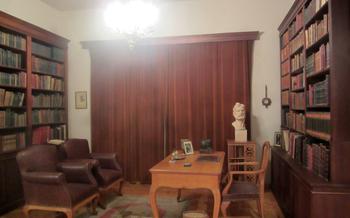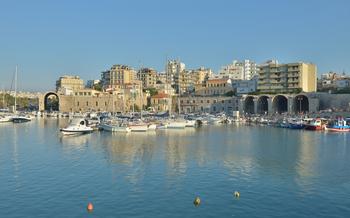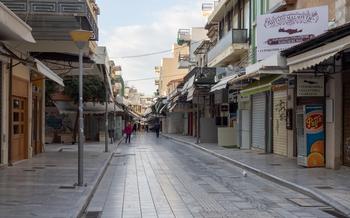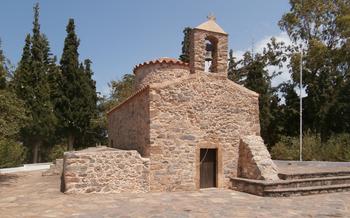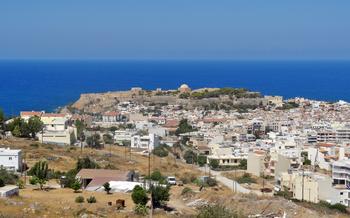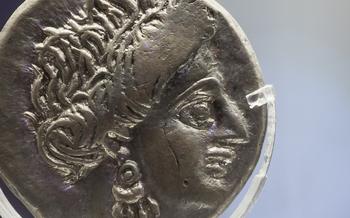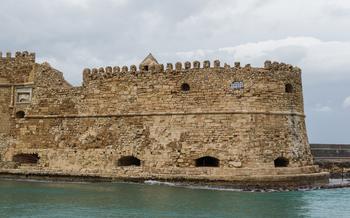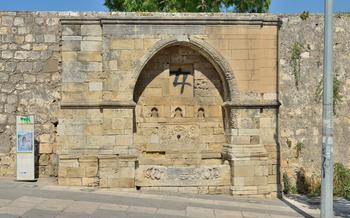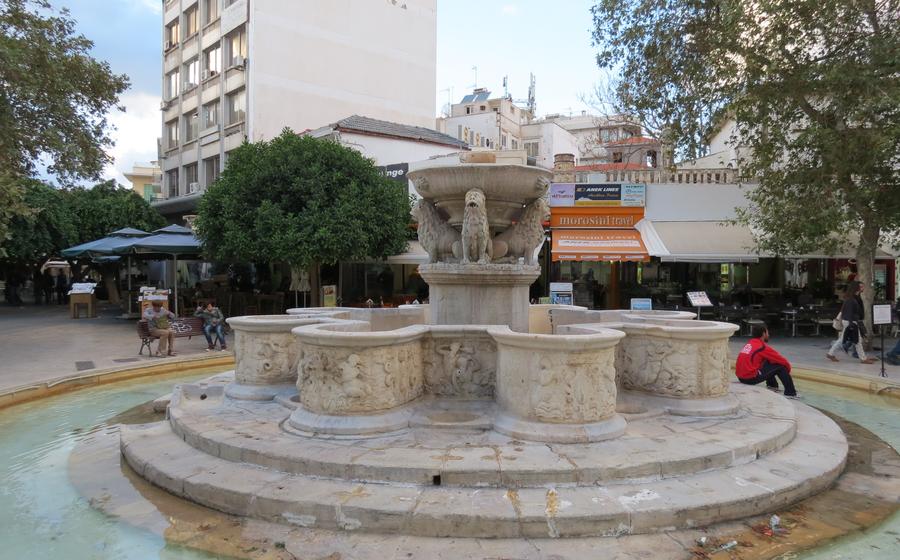
Lions Square and Morosini Fountain
- Lions Square: An Ode to Venetian Heritage
- Exploring the Venetian Walls: A Walk Through History
- The Venetian Fortress: A Bastion of Defense
- Koules Fortress: A Majestic Sea Fortress
- Loggia: A Gathering Place for Venetian Nobles
- Venetian Harbor: A Hub of Maritime Activity
- St. Mark's Basilica: A Venetian Architectural Masterpiece
- Heraklion Archaeological Museum: A Treasure Trove of Minoan Artifacts
- Knossos Palace: A Minoan Labyrinth
- Gortys: A Journey to the Past
- Archanes: A Minoan Settlement
- Crete Aquarium: A Marine Adventure
- Insider Tip: Hidden Gems Off the Beaten Path
Lions Square: An Ode to Venetian Heritage
Lions Square, also known as Plateia Venizelou, stands as a testament to Heraklion's rich Venetian past. Once the heart of the Venetian city, it served as a gathering place for Venetian nobles and officials. The square's architectural grandeur is evident in the surrounding buildings, which showcase Venetian and Renaissance influences. Cafes, restaurants, and shops line the square, creating a lively atmosphere that transports visitors back in time. To fully immerse yourself in the Venetian legacy, visit Lions Square in the evening when the lights illuminate the buildings and the square comes alive with locals and tourists alike.
Exploring the Venetian Walls: A Walk Through History
The Venetian walls of Heraklion stand as a testament to the city's rich history and its strategic importance as a major trading hub during the Venetian era. Constructed between the 15th and 17th centuries, these imposing fortifications once protected the city from invaders and served as a symbol of Venetian power.
Today, the Venetian walls offer visitors a unique opportunity to step back in time and experience the grandeur of this bygone era. The walls stretch for several kilometers, encircling the old city of Heraklion and providing breathtaking views of the city and the surrounding landscape.
Exploring the Venetian walls on foot or by bike is a delightful way to discover their hidden gems and appreciate their architectural details. Along the way, visitors can admire the massive gates, bastions, and towers that once guarded the city, as well as the charming streets and neighborhoods that have sprung up within the walls.
The Venetian Fortress: A Bastion of Defense
The Venetian fortress stands as a testament to the strategic importance of Heraklion during Venetian rule. Constructed in the 16th century, this impressive fortress played a crucial role in defending the city against invaders. Its formidable walls, towers, and dungeons have withstood the test of time, offering a glimpse into the city's rich military history.
Exploring the fortress is like stepping back in time. Walk along the ramparts and admire the stunning views of the harbor and the city. Climb the towers to experience the vantage point of the Venetian sentries. Descend into the dungeons to imagine the conditions endured by prisoners held within these dark and forbidding chambers.
Today, the fortress is open to the public and hosts cultural events and exhibitions throughout the year. Visitors can wander through the fortress's grounds, soaking in the ambiance of this historic site while learning about its fascinating past. The fortress is a must-visit for anyone interested in history, architecture, or simply marveling at the ingenuity of the Venetian engineers who designed and built this impressive structure.
Koules Fortress: A Majestic Sea Fortress
Perched on the western edge of Heraklion's Venetian harbor, Koules Fortress stands as a testament to the city's rich maritime heritage. Built in the 16th century by the Venetians to protect the harbor from invaders, the fortress is a magnificent example of Venetian military architecture. Its imposing walls, sturdy towers, and strategic location made it a formidable defense against enemy attacks.
Koules Fortress boasts a unique architectural design, blending Venetian and Ottoman influences. Its massive stone ramparts, adorned with intricate carvings and decorative elements, reflect the artistic prowess of the Venetian builders. The fortress comprises two main sections: the outer wall, which forms a protective barrier around the harbor, and the inner keep, which served as the fortress's main defensive stronghold.
Inside the fortress, visitors can explore a labyrinth of chambers, tunnels, and dungeons, each revealing a glimpse into the fortress's past. The fortress's strategic position offered stunning views of the harbor and the city, allowing its defenders to keep watch for approaching enemies.
Today, Koules Fortress stands as a proud symbol of Heraklion's Venetian heritage. It has been carefully restored and transformed into a cultural venue, hosting exhibitions, concerts, and other events throughout the year. Visitors can climb to the fortress's ramparts to enjoy breathtaking panoramic views of the Venetian harbor, the city skyline, and the sparkling Mediterranean Sea.
Loggia: A Gathering Place for Venetian Nobles
The Loggia, an architectural masterpiece from the Venetian era, stands as a testament to the grandeur of Heraklion's past. Built in the 16th century as a meeting place for Venetian officials and merchants, this elegant building exudes an aura of historical significance.
Architectural Details and Design
The Loggia boasts intricate architectural details that showcase the Venetian Renaissance style. Its façade features a series of graceful arches supported by slender columns, creating a harmonious rhythm that draws the eye. The building's upper level is adorned with decorative balustrades and ornate carvings, reflecting the artistic sensibilities of the Venetian artisans.
Current Use as a Cultural Center
Today, the Loggia has been transformed into a vibrant cultural center, hosting a variety of exhibitions and events throughout the year. These events range from art exhibitions showcasing local and international artists to musical performances, lectures, and workshops. The Loggia's transformation into a cultural hub has breathed new life into this historic building, making it a popular destination for both locals and visitors.
Exhibitions and Events
The Loggia's exhibitions often focus on Venetian history, art, and culture, providing visitors with a glimpse into the rich heritage of Heraklion. The events held at the Loggia are diverse and cater to a wide range of interests, ensuring that there is something for everyone to enjoy. Whether you are an art enthusiast, a history buff, or simply looking for a unique cultural experience, the Loggia is sure to offer something that will captivate and inspire you.
Venetian Harbor: A Hub of Maritime Activity
The Venetian Harbor, also known as the Old Harbor, is a picturesque and vibrant area that once served as a crucial hub of maritime activity during the Venetian era. Today, it retains its charm and offers visitors a glimpse into Heraklion's rich maritime history.
Strolling along the harbor's promenade, you'll be captivated by the colorful fishing boats and sleek yachts bobbing on the water. The surrounding buildings, with their Venetian architectural influences, add to the harbor's unique atmosphere.
As you wander through the narrow streets and alleyways, you'll discover charming cafes and restaurants where you can savor delicious seafood dishes while enjoying the views of the harbor. The air is filled with the sounds of seagulls, the gentle lapping of waves, and the lively chatter of locals and tourists alike.
Take your time to explore the harbor's surroundings, where you'll find historical landmarks such as the Venetian Arsenal, once used for shipbuilding and repairs. The imposing Venetian walls, with their massive bastions and towers, stand as silent witnesses to the city's rich past.
As the sun begins to set, the harbor transforms into a magical place. The sky is painted with hues of orange and purple, reflecting on the water and creating a breathtaking spectacle. Whether you choose to take a leisurely stroll, enjoy a romantic dinner by the waterfront, or simply sit and watch the world go by, the Venetian Harbor is the perfect place to soak up the unique atmosphere of Heraklion.
St. Mark's Basilica: A Venetian Architectural Masterpiece
Standing proudly in the heart of Heraklion, St. Mark's Basilica is a stunning testament to Venetian architectural prowess and a symbol of the city's rich history. Constructed in the 13th century, the basilica served as the cathedral of the Roman Catholic Archdiocese of Crete during the Venetian rule. Its grandeur and intricate design have made it a beloved landmark, attracting visitors from around the world.
Architectural Marvel:
St. Mark's Basilica boasts a captivating blend of Venetian Gothic and Renaissance architectural styles. Its imposing facade is adorned with intricate carvings, sculptures, and a magnificent rose window. The interior is equally impressive, with soaring vaulted ceilings, elegant arches, and a wealth of frescoes and mosaics. The basilica's most striking feature is its bell tower, a towering structure that offers panoramic views of the city and the surrounding countryside.
Religious Significance:
St. Mark's Basilica holds great religious significance for both the Catholic and Orthodox communities of Heraklion. It was originally dedicated to St. Titus, the first bishop of Crete, but was later renamed in honor of St. Mark the Evangelist, the patron saint of Venice. Throughout the centuries, the basilica has been a place of worship, pilgrimage, and spiritual reflection for people of all faiths.
Cultural Icon:
Beyond its religious significance, St. Mark's Basilica has become a cultural icon of Heraklion. It is a symbol of the city's Venetian heritage and a reminder of the vibrant cultural exchange that took place during that era. The basilica frequently hosts concerts, exhibitions, and other cultural events, showcasing the diverse artistic traditions of Crete.
Exploring the Basilica:
To fully appreciate the beauty and significance of St. Mark's Basilica, visitors should take their time to explore its every nook and cranny. Admire the intricate details of the facade, marvel at the soaring interior, and soak in the serene atmosphere. Be sure to climb the bell tower for breathtaking views of the city and the Venetian harbor.
Insider Tip:
For a truly immersive experience, visit St. Mark's Basilica during one of the many religious festivals held throughout the year. Witness the vibrant processions, listen to the enchanting hymns, and immerse yourself in the spiritual traditions of Crete.
Heraklion Archaeological Museum: A Treasure Trove of Minoan Artifacts
The Heraklion Archaeological Museum stands as a testament to the rich history and cultural heritage of Crete. Founded in 1883, the museum houses an extensive collection of artifacts from the Minoan civilization, offering a glimpse into the lives and culture of this ancient people.
The museum's exhibits span various periods of Minoan history, from the early Bronze Age to the Late Minoan era. Visitors can marvel at the exquisite Minoan frescoes, depicting scenes of everyday life, religious rituals, and mythological creatures. These vibrant and detailed paintings provide invaluable insights into Minoan art and society.
Among the highlights of the collection is the iconic Snake Goddess statuette, a masterpiece of Minoan sculpture. Crafted from faience, this figurine depicts a goddess adorned with snakes, symbolizing her connection to the natural world and fertility. Its intricate details and graceful form continue to captivate visitors to this day.
The museum also boasts an impressive collection of Minoan pottery, showcasing the exceptional craftsmanship and artistic flair of the Minoans. From simple utilitarian vessels to elaborately decorated vases, these artifacts provide a glimpse into the everyday lives and customs of this ancient civilization.
To make the most of your visit, consider joining a guided tour led by knowledgeable experts who can provide insights into the history and significance of the exhibits. Alternatively, rent an audio guide to explore the museum at your own pace and learn about the artifacts in detail.
Whether you're a history buff, an art enthusiast, or simply curious about the Minoan civilization, the Heraklion Archaeological Museum is a must-visit destination. Its treasures offer a captivating glimpse into the past, inviting visitors to connect with the rich cultural heritage of Crete.
Knossos Palace: A Minoan Labyrinth
Journey back in time to the Bronze Age and explore the fascinating ruins of Knossos Palace, the legendary seat of the Minoan civilization. Located just a short distance from Heraklion, this awe-inspiring palace is a must-see for anyone interested in ancient history and archaeology.
Uncover the secrets of the Minoans as you wander through the palace's sprawling complex, marveling at its intricate architecture and well-preserved frescoes. Explore the grand staircases, ceremonial chambers, and royal apartments, each telling a story of a vibrant and sophisticated civilization.
Immerse yourself in the myths and legends that surround Knossos, including the tale of the Minotaur and the daring escape of Theseus. Let your imagination run wild as you envision the palace's former glory, filled with Minoan kings and queens, elaborate feasts, and religious ceremonies.
To make the most of your visit, arrive early to avoid the crowds and bring comfortable shoes for exploring the extensive ruins. Don't forget your camera to capture the stunning views of the surrounding countryside from the palace's elevated position.
Knossos Palace is not just a historical site but a gateway to a bygone era, offering a glimpse into the lives and culture of the Minoans, one of the most advanced civilizations of the ancient world.
Gortys: A Journey to the Past
Gortys, located in the Messara plain, is a fascinating ancient Greek city that offers a glimpse into a rich and storied past. Founded in the 8th century BC, Gortys was one of the most important cities in Crete and played a significant role in the island's history. Today, visitors can explore the ruins of this ancient city and discover its many well-preserved treasures.
One of the highlights of Gortys is the Odeon, a small theater that was used for musical and theatrical performances. The Odeon is remarkably well-preserved, and visitors can still see the stage, the seating area, and the intricate acoustic system. Another must-see attraction is the Agora, the ancient marketplace. The Agora was the center of commercial activity in Gortys, and visitors can still see the remains of the shops, stalls, and temples that once lined its streets.
Perhaps the most famous attraction in Gortys is the Temple of Apollo, which dates back to the 7th century BC. The temple was dedicated to the Greek god Apollo, and it was one of the most important religious sites in the city. Today, visitors can see the ruins of the temple, including the impressive columns that once supported its roof.
In addition to these major attractions, Gortys is also home to a number of other interesting sites, including the Gortyn Code, one of the oldest legal codes in the world. The Gortyn Code is inscribed on a large stone slab, and it provides a fascinating glimpse into the legal system of ancient Gortys.
Tips for Visiting Gortys:
- Gortys is located about 40 kilometers south of Heraklion. It is easily accessible by car or bus.
- The best time to visit Gortys is in the spring or fall, when the weather is mild.
- Wear comfortable shoes, as you will be doing a lot of walking.
- Bring water and snacks, as there are no shops or restaurants in the immediate vicinity of the ruins.
- Allow at least two hours to explore the ruins of Gortys.
- Combine your visit to Gortys with a visit to other nearby attractions, such as the Phaistos Palace or the Matala Caves.
Archanes: A Minoan Settlement
Just a short drive from Heraklion, the village of Archanes offers a glimpse into the ancient Minoan civilization. This settlement, dating back to the Bronze Age, was one of the most important Minoan centers on Crete. Exploring the ruins of Archanes is like stepping back in time and unraveling the mysteries of this enigmatic civilization.
Stroll through the excavated remains of Minoan houses, marveling at their well-preserved architecture. Admire the intricate frescoes that once adorned the walls, depicting scenes from daily life and religious rituals. The highlight of Archanes is undoubtedly the Royal Villa, believed to have been the residence of a Minoan ruler. Explore its grand chambers, storage rooms, and workshops, and imagine the bustling life that once took place within these walls.
Don't miss the Archanes Tholos Tomb, located just outside the village. This impressive circular tomb, with its corbelled roof and intricate interior, is one of the best-preserved Minoan tombs in Crete. As you stand inside the tomb, surrounded by the ancient stone walls, you can't help but feel a connection to the past and the people who built this remarkable structure.
Visiting Archanes is a unique opportunity to immerse yourself in the history and culture of the Minoan civilization. Combine your visit with other nearby attractions, such as the Knossos Palace and the Heraklion Archaeological Museum, for a comprehensive exploration of Crete's rich past.
Crete Aquarium: A Marine Adventure
Immerse yourself in the captivating underwater world of the Mediterranean Sea at the Crete Aquarium, a must-visit attraction for marine enthusiasts. Discover the diverse marine life that inhabits the Cretan waters, from the majestic sharks and graceful rays to the colorful reef fish and mysterious octopuses.
Explore the aquarium's various exhibits, each showcasing a unique habitat and species. Learn about the delicate balance of the marine ecosystem and the importance of protecting our oceans. Get up close with the fascinating creatures that call the Mediterranean Sea their home, observing their behavior and learning about their unique adaptations.
The Crete Aquarium is not just an educational experience but also a fun and interactive adventure. Engage in hands-on activities, watch captivating feeding demonstrations, and participate in educational workshops. Marvel at the mesmerizing colors and intricate patterns of the coral reefs, and witness the playful antics of the dolphins and seals.
Plan your visit during the aquarium's feeding times to witness the marine creatures' impressive hunting skills and learn about their dietary habits. Capture stunning underwater photographs to cherish your memories of this marine adventure.
The Crete Aquarium is easily accessible and offers a range of facilities to enhance your experience. Enjoy a delicious meal at the on-site restaurant, browse the gift shop for souvenirs, and take advantage of the educational resources available.
Whether you're a family with children, a couple seeking a unique experience, or a solo traveler passionate about marine life, the Crete Aquarium promises an unforgettable journey into the depths of the Mediterranean Sea.
Insider Tip: Hidden Gems Off the Beaten Path
Beyond the popular tourist spots, Heraklion conceals a treasure trove of hidden gems that offer a glimpse into the city's rich Venetian past. Explore the lesser-known churches, such as the Church of San Salvatore or the Church of Santa Maria della Misericordia, which showcase stunning Venetian architecture and religious artworks. Discover hidden monasteries, like the Monastery of San Francesco or the Monastery of Santo Domingo, which provide a serene escape from the city's hustle and bustle. Unveil the secrets of the Venetian walls and fortifications by exploring the hidden passages and towers that offer unique perspectives of the city. Venture off the beaten path to uncover these hidden gems and create a truly unforgettable itinerary.
